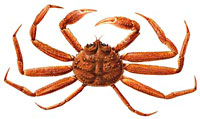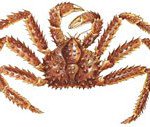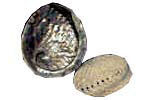
Chionoecetes opilio
The snow crab (Chionoecetes opilio) belongs to class Crustacea, and order Decapoda and is one of the most important commercial species of Decapoda in the
Russian Far Eastern Seas. (It is also the largest crab fishery in Alaska). Snow crabs inhabit the cold waters of the Sea of Japan east of the Korean Peninsula, the Sea of Okhotsk, the Bering Sea, and can be found in the northwest Atlantic, on sandy or muddy bottoms at temperatures ranging from -1 to 5oC and at depths varying between 20 and 420 m.
Because of its wide distribution, the snow crab has a number of other common names, including the spider crab and queen crab in English, crabe des neiges and crabe araignée in French, and zuwai gani in Japanese.
Crabs have broad, flattened, circular bodies that are covered by a hard shell or carapace, and grow by moulting their shell. It is believed that after the male crab becomes mature, they no longer possess the functioning Y-organs which provide the hormone that causes moulting. During moulting in immature specimens, the secreted hormone causes cuticle to be produced to replace the cuticular surface which has been moulted, or to replace damaged cuticle.
Snow crabs have circular bodies surrounded by five pairs of long, flat legs. Crabs caught for commercial purposes range in size from 9.5 to 15 cm in width, and weigh between 350 grams to 1.3 kilograms. Snow crabs are dimorphic (they exist in two distinct forms) with males growing much larger than females, and consequently account for most crabs caught commercially. Males may reach a maximum carapace width of 16.5 cm, a leg span of 90 cm and a weight of 1.35 kg. The female grows to a maximum carapace width of 9.5 cm, with a leg span of 38 cm and a weight of 0.45 kg. The abdomen of the male is quadrilateral in shape (like a truncated pyramid), while the female has a circular abdomen
The snow crab diet is diverse and is composed primarily of algae, molluscs, small crustacea and marine worms.








Social Profiles